Discover the rich history and colonial architecture of São Luís do Maranhão, a heritage site that reflects the cultural heritage and unique beauty of one of Brazil’s most important historical centres.
The Historic Centre of São Luís do Maranhão stands out for the uniformity and simple, regular, beauty of its buildings, forming one of the largest architectural ensembles of Portuguese essence still preserved in Latin America.
This heritage reflects the city’s rich culture and history, which combines indigenous, African and European influences.
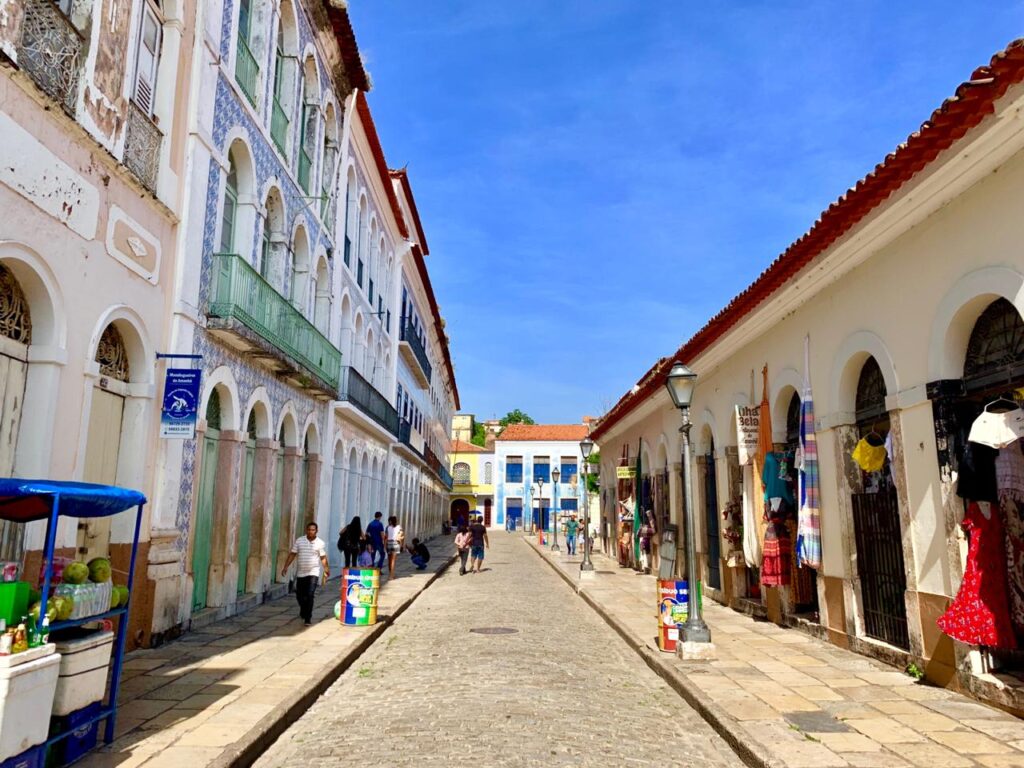
Historical heritage
The architecture we inherited from the Portuguese is one of the richest aspects of São Luís’ historical heritage.
The collection of colonial mansions reflects the way of life of the colonisers who arrived in the city, offering a glimpse of the past and the cultural influences that have shaped the region.
This architectural ensemble is so important that it was declared a World Heritage Site by UNESCO in 1997, reinforcing its importance in the global cultural and historical context.
Tiles
One of the most striking details of the architectural formation of São Luís is undoubtedly its tiles. The capital’s tile collection contains gems that reveal what the capital of Maranhão was like a few centuries ago: a place full of luxury and sophistication.
The tiles not only embellish the façades, but also have a practical function.
They strongly reflect the sun’s rays and reduce the heat inside buildings because they absorb less heat. Tiles thus have the dual function of beautifying and maintaining the quality of the environment in an equatorial climate.
Architectural collection
The historic centre has a colonial architectural collection of around 4,000 buildings, spread over more than 220 hectares, most of which are townhouses with belvederes, many covered with Portuguese tiles.
These buildings were built by the landowners who ran the cotton production in the region, and represent the city’s economic heyday during the cotton cycle.
Cultural life
Formed by the Praia Grande and Desterro districts, the area is now home to Museums, Cultural Centres, Theatres, Cinemas, Bars, Restaurants, Fairs and a variety of Crafts Shops.
There are also squares, charming alleys, staircases, hillsides and some of the most beautiful streets in the historic part of the city, such as Rua Portugal, Rua do Giz and Largo do Comércio.
It’s important to note that the Historic Centre area is closed to traffic, making it a more pleasant and safer environment for visitors.
Praia Grande is perfect for peaceful walks and it is recommended that you wear trainers and flat sandals to walk on the cobbled surface and up and down the steps and stairs. Light clothing and Sun cream are recommended to ensure comfort during your visit.
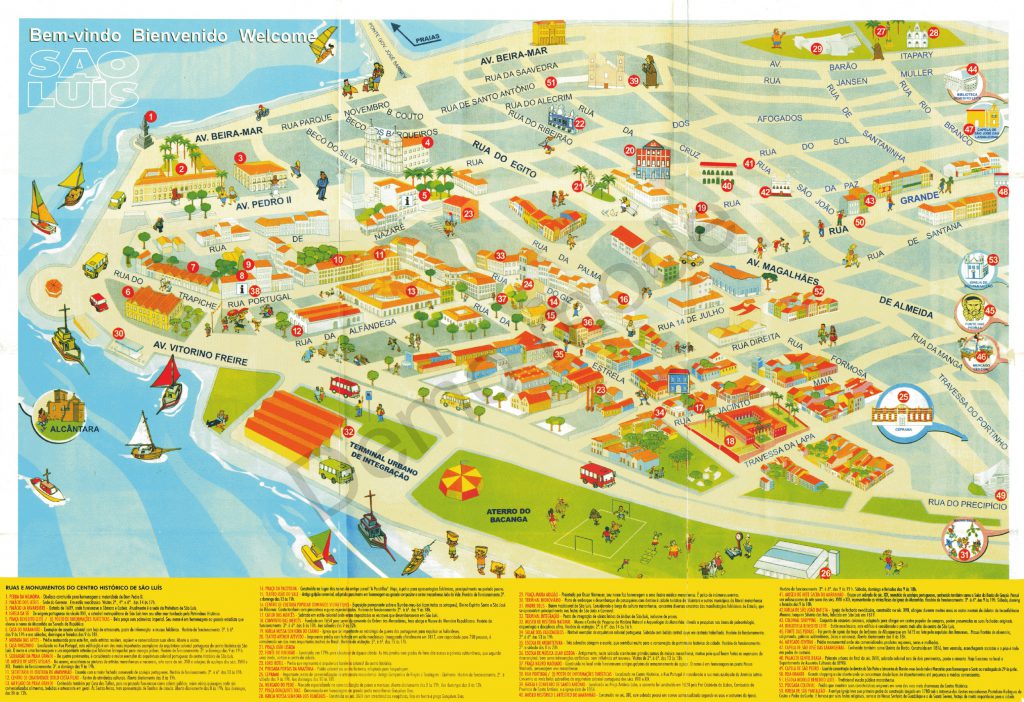
Videos about Historic Centre of São Luís
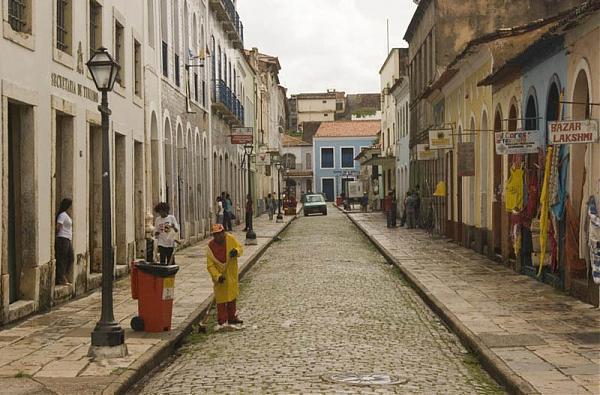

Centro histórico de São Luís do Maranhão - Parte 107:15
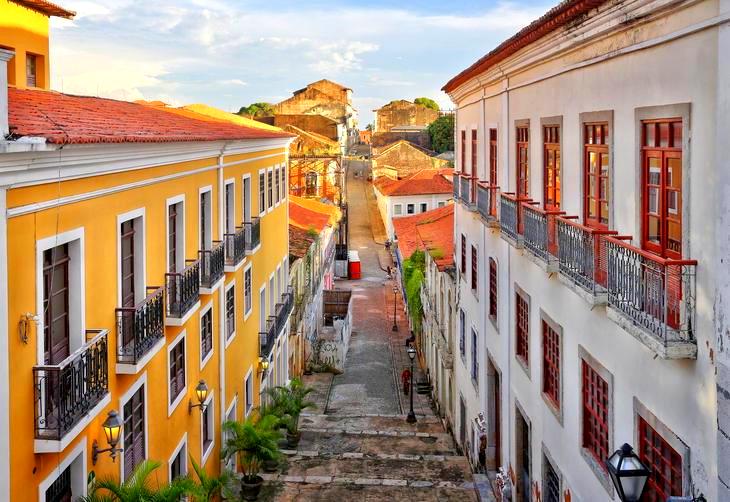
Centro histórico de São Luís do Maranhão - Parte 208:30
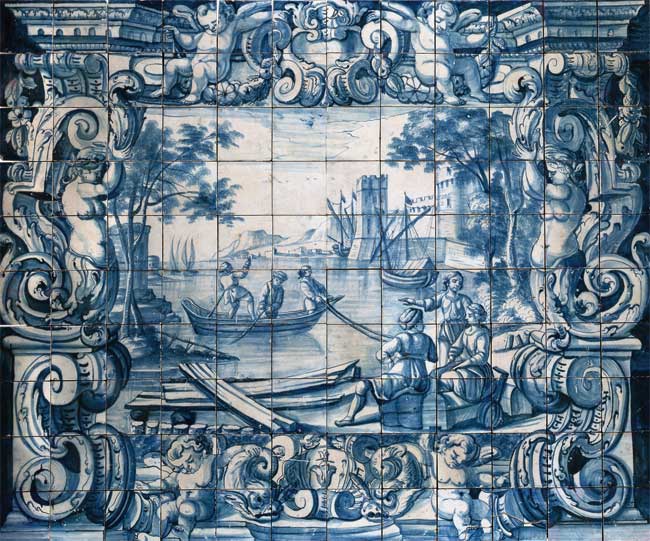
História dos azulejos de São Luís04:10

São Luís - Tour pelo belíssimo Centro Histórico25:49
Colonial buildings and the architectural complex of São Luís
- The origins of the colonial buildings in São Luís
- Architectural and urban complexes of the 18th, 19th and 20th centuries
- Architecture of houses and townhouses in São Luís
- Tiles on the façades of São Luís do Maranhão
- Tourist Attractions in the Historic Centre of São Luís MA
1. The origins of colonial buildings in São Luís: a historical analysis
Antônia Mota, a historian at the Federal University of Maranhão, has carried out several studies on the origins of colonial buildings. According to her, most of the historic buildings were built more than a century after the foundation of São Luís.
Economic and social context
It was a promising time for trade, as the Lusitanian elite resided in the city. “Through the Companhia de Comércio do Grão-Pará e Maranhão, the Marquis of Pombal brought in resources, and it was during this period that the cultivation and export of cotton and rice developed, favouring the development of the region. This attracted many Portuguese in search of business and also led to the arrival of African slaves to work on the plantations, culminating in a large increase in the population,” explains Antônia Mota.
Architectural influences
The professor points out that the city benefited from the reconstruction of Lisbon, which had been devastated by a earthquake. “São Luís became the residence of landowners and merchants. In some ways, the city resembled Lisbon, as the construction techniques were influenced by this period of reconstruction,” she says.
The carved stones, known as pedras de cantaria, which line the pavements and streets of the Historic Centre, were brought to São Luís as ballast from Portuguese ships.
Architectural heritage and tourism
Today, all this architecture still enchants people from all over the world who visit the city. Fábio Colignac, who has been running an inn for six years in a mansion built in 1835 in the historic centre, emphasises the importance of this heritage.
Tourists are impressed by the time travel offered by the hotel. The building, like many from the period, has a central plan where the manor house is located – a communal area usually decorated with trees and plants. The rooms are arranged around it and the bedrooms are comfortable, retaining the main original features.
The staircases, the wooden floors, the handrails and even the scapulas of the hammocks are authentic. “That is the big challenge: to adapt this villa without giving up the comforts you would normally expect in a hotel, such as air conditioning and a private bathroom with hot water,” says Fábio.
Visitors’ impressions
Greek Nikos Papazarkada, from Athens, fell in love with what he found in the city. He claims to have never seen anything like it in the world and describes everything as beautiful and enchanting. For many, the scenery of Maranhão’s capital is truly irresistible, and this admiration has lasted for 400 years.
2. São Luís Architectural and Urban Complex: 18th, 19th and 20th Century
In its old centre, São Luís has an architectural and urban ensemble from the 18th, 19th and 20th centuries, with around 5,600 properties classified by the State and Federal Governments, spread over the vast area that makes up the Historic Centre.
Diversity of architectural styles
The existing buildings reflect a variety of periods and styles, including traditional Portuguese, neoclassical, eclectic, neocolonial, art deco and modern, most of which are civil architecture. The dominant architectural typology in the urban landscape is made up of sobrados (buildings with more than one floor), solares, moradas-inteiras, moradas-e-meia, ¾ moradas, meias-moradas and portas-e-janelas.
There are a considerable number of buildings with tiled facades, many of them from the 19th century, mainly from Portugal.
History and development
The oldest examples of architecture date from the 18th and 19th centuries. In the early years of Portuguese colonisation and until the middle of the 18th century, Maranhão’s economy was limited to subsistence production. The Maranhão historian Mário Meireles describes the miserable situation of São Luís in 1683 as a city that was “cramped, with crooked, cobbled streets, in which almost all the houses were made of mud, covered with straw, with urupemas on the windows”.
The state’s economy began to develop in 1755 with the creation of the Companhia Geral do Grão-Pará e Maranhão. This company, structured by the Marquis of Pombal, minister of King José I (1750-1777), promoted the acquisition of tools and slave labour through financing, placing Maranhão in the production and export circuit of agricultural products, especially cotton.
Social and economic impact
Marques (1970) comments that the creation of the company “profoundly changed the life of the state, opening up its agriculture and commerce to a period of open progress that translated into the material enrichment and intellectual improvement of society”.
However, Maranhão’s promising economy, based essentially on slave labour to produce the crops, began to decline at the end of the 19th century, shortly after the abolition of slavery in 1888. This decline was exacerbated by the consequences of the fall in the price of cotton on the international market.
The attempts, not always successful, to replace agricultural activity with the establishment of textile industries culminated in the stagnation of Maranhão at the end of the 19th century and inevitably had a strong impact on the urban development of São Luís.

3. architecture of houses and sobrados in São Luís
The ups and downs of the slopes and stairs of the Historic Centre of São Luís reveal the nuances of Luso-Brazilian colonial architecture.
Reflection of social position
The façades of the houses lining the streets of Praia Grande reflected the social status of their owners. They were joined by churches, chapels, official buildings, farmhouses and industrial plants, giving the town its links and identity.
Population growth and economic change
In the second half of the 18th century, the city experienced a leap in population, from 854 inhabitants to 16,580, mainly due to the migration of families from the Azores archipelago and, above all, the introduction of African slave labour. This growth meant that the district began to concentrate economic activity, with the opening of commercial premises, resulting in a greater appreciation of urban land and a diversity in the size of plots.
Architectural patterns
Doors and windows, Framed houses and Town houses are some of the patterns of the buildings built in the city. Throughout the formation of this urban network, the old centre did not distinguish between main and secondary streets and did not impose the formation of exclusive residential areas. Housing and Business coexisted in the same space, giving the city an air of architectural homogeneity.
Types of housing
There are many variations of housing, including
- Door and window
- Half an apartment
- Three quarters (3/4) of an address
- Whole address
- Half and half
- One-storey commercial house
- One-storey house with basement
- One-storey house with basement and gazebo
- Two and three storey houses, with or without basement and/or gazebo
- Four-storey townhouses
These dwellings are characterised by the number of rooms rather than their decoration or construction systems.
Trade and residential structures
With the growth of trade, the houses in Ludovico began to have street doors. In general, the ground floor was dedicated to commercial activities, while the upper floors were reserved for intimate spaces with direct communication between them. Another peculiarity of the region’s houses are the hooks for hammocks scattered throughout the rooms, a custom that continues to this day.
Urban patterns
Because the plots were deeper than they were wide, the buildings followed urban patterns that favoured air circulation and lighting. These buildings were developed in five main plans: rectangular, L-shaped, C-shaped, U-shaped and O-shaped, with the L and U shapes dominating.

See also Colours of houses and buildings in northeastern colonial architecture.
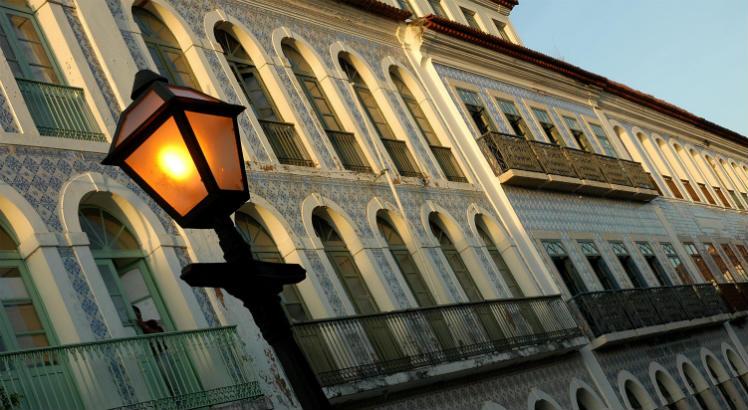
See the History and chronology of Portuguese tiles
4. Façade tiles in São Luís do Maranhão
The first information about tiles in São Luís, according to Professor Dora Alcântara, appears in the “news about an import in the 18thcentury” provided by Domingos Vieira Filho in his recently published work, Azulejaria no Maranhão.
In this work, the historian Domingos Vieira Filho states that 107,402 tiles arrived in São Luís in 1778. These tiles were probably used as quoins inside churches or houses, as the taste for tiling the facades of single-storey houses and city houses in Maranhão did not begin until the 1840s.
The new use of tiles
In the middle of the 19th century, as Dora Alcântara reports in her work Azulejos Portugueses em São Luís do Maranhão, “a new way of using tiles emerged in Brazil, moving them from the interior of churches, convents, palaces or buildings for official use to the exterior” of facades.
Exterior tiling became widespread in the coastal cities from north to south, with Belém, São Luís, Recife, Salvador, Rio de Janeiro and Port Alegre standing out, among other cities that practised façade tiling less frequently.
Acceptance of bricks in the 19th century
In the 19th century, the golden age of Maranhão’s economy, tiles were widely accepted as a material for cladding façades, especially in the properties of Portuguese mill owners and merchants, who were enriched by the production and export of cotton and rice.
This acceptance is attributed to the aesthetic improvement that tiles bring to façades, while protecting them from the winter rains that fall for six months in the region.
In addition to Portugal, where most of the tiles were made, São Luís also received tiles from other countries, such as France, Belgium and Germany, albeit in smaller quantities.
In the 19th century, a significant number of carpet tiles with different patterns, made using the stamped technique, were imported from Portugal for use on the facades of houses in São Luís.
Between 1843 and 1879, several ships arrived at the port of São Luís with loads of tiles, 90 per cent of which came from Lisbon and the rest from the city of Porto.
Use of tiles on facades
Façade tiling may be applied in full, in part or as isolated ornamentation. The tiling is usually on the main facade (including the front of the belvederes), but in some corner properties the side facade is also fully or partially tiled.
The tiles covering the façades are of the carpet or plain type, made using stamped, decorated, relief and marbled techniques. Most of the patterns define the composition by repeating (with rotation) four pieces, but there are also patterns where the composition is defined in a single piece.
Most of the tiles that arrived in Maranhão have a 13.5 cm x 13.5 cm format. The borders are 6.75 cm x 13.5 cm (friezes), with a corner piece measuring 6.75 cm x 6.75 cm and borders measuring 13 . 5 cm x 13 . 5 cm.
If there was no suitable corner piece for a particular frieze, it was common to make a half-square cut (45º) to match the orthogonal combination of the frieze. Some tiles, due to their geometric design structure, allow for variations in the composition of the carpet.
Special characteristics
In São Luís, the configuration or positioning of the tiles on the façades has acquired peculiar characteristics due to the different ways in which a standard unit is applied, resulting in different compositions of carpets from the same tile.
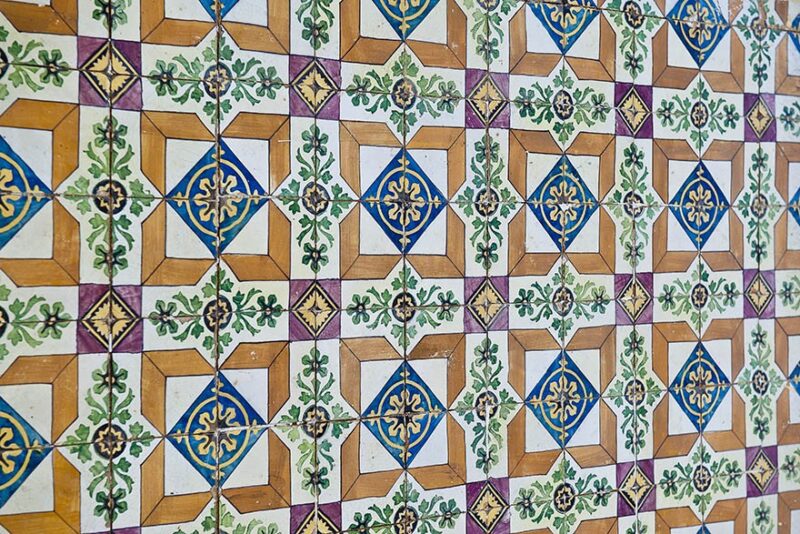














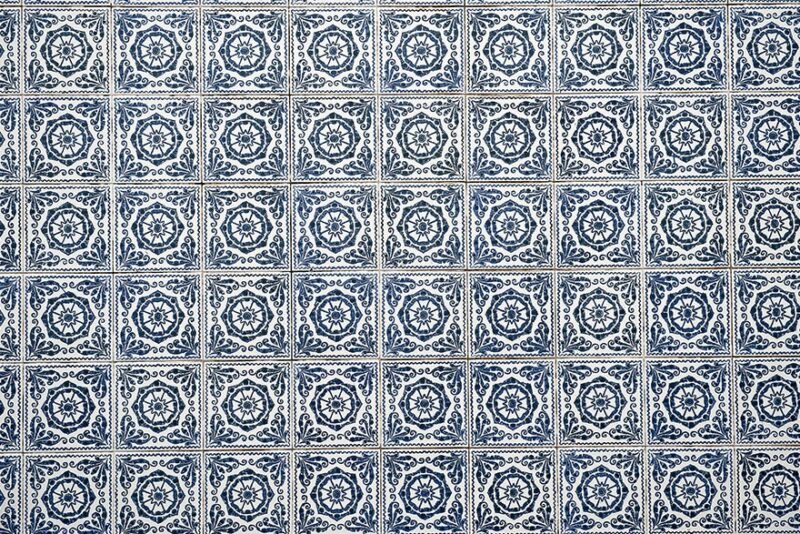
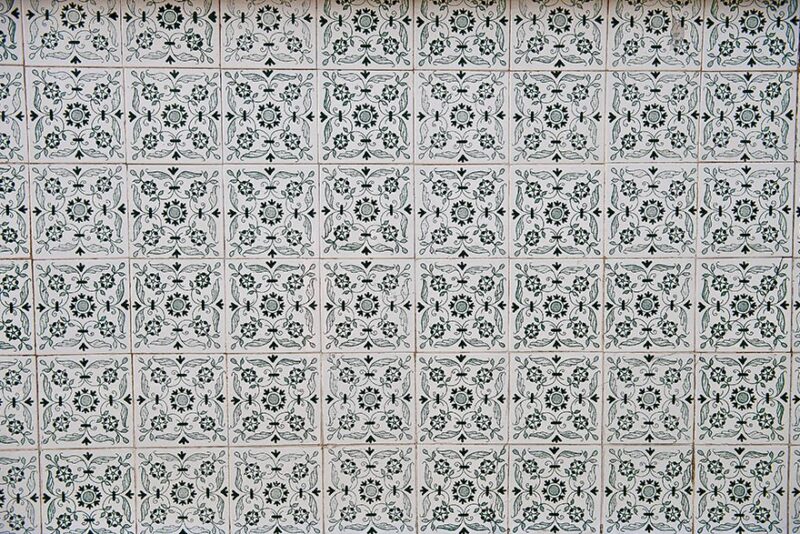
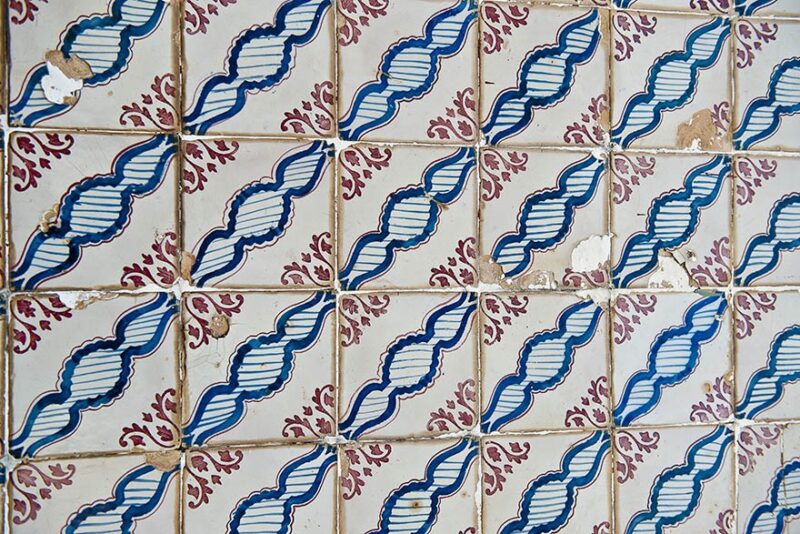
See the work – facade tiles of São Luís do Maranhão
5. Tourist Attractions in the Historic Centre of São Luís MA
- Sé Church and Episcopal Palace
- La Ravardière Palace
- Palace of Christ the King
- Palace of the Lions
- Benedito Leite Square
- Portugal Street and Trapiche Street
- Mercês Monastery
- Arthur Azevedo Theatre
- Cafua das Mercês
- House of Maranhão
- Commercial Square
- Stone Fountain
- Ribeirão Fountain
- Tulhas Market
- Nhozinho House Museum
- Solar dos Vasconcelos Museum – Historic Centre Memorial
- Historical and Artistic Museum of Maranhão
- Museum of Religious Art
- Avenue of Catarina Mina
- João do Vale Theatre
- Odylo Costa Filho Creativity Centre
- Alcione Nazaré Theatre
1. Sé Church and Episcopal Palace
It is said that at the beginning of colonisation, when the Portuguese and French fought for control of the country, the Battle of Guaxenduba(1614) took place.

Outnumbered by La Ravardière, Jerônimo de Albuquerque’s forces were reinforced by a female figure who gave the fighters strength by serving them gunpowder made from the dust of the earth.
Address: Av. Pedro II, S/N – Centre
2. La Ravardière Palace
An example of a colonial administrative building, the Palais de La Ravardière was named in 1962 on the occasion of the city’s 350th anniversary.

It was built around 1689 and is one of the oldest buildings in the region. Today it is the seat of the municipal government and contains a bronze bust of Daniel de La Touche, Lord of La Ravardière, the French commander and founder of São Luís.
Address: Avenida D. Pedro II, next to Palácio dos Leões.
Visits: external visits only.
3. Cristo Rei Palace

Built in 1838 as the residence of Comendador José Joaquim Teixeira Vieira, the property represents the luxury of the wealthy families of the colonial period.
It was sold in 1900 to the then US vice-consul, who owned a banking house in São Luís. It is said that the consul used to serve the most exquisite delicacies to beggars and the needy, which is why he was called “padrinho” (godfather).
In 1908, due to the bankruptcy of his bank and his numerous debts, he committed suicide and had the property auctioned. Since then, the palace has had many owners, until in 1953 it became the seat of the Archbishopric and was renamed “Palácio Cristo Rei”. Today it houses the rectory of the Federal University of Maranhão.
Address: Praça Gonçalves, 351 – Largo dos Amores Dias – Centre
Visits: Monday to Friday, 8am to 11am and 2pm to 5pm.
4. Palace of the Lions

Covering an area of 3,000 square metres, with exquisite neoclassical architecture and overlooking São Marcos Bay, the Palácio dos Leões serves as the official residence and headquarters of the Government of Maranhão.
It became known as Palácio dos Leões (Fort of São Felipe) because of the bronze lions that guard its entrances. Built on the site of the former São Luís Fort, it took the form of a palace in 1776, when Governor Joaquim de Mello e Povoas remodeled the building using materials from the extinct Jesuit house in Alcântara.
Completely restored, it is worth visiting not only for its architecture and splendour, but also for the artistic treasures and relics it contains.
Address: Av. Pedro II, S/N – Centre
Visits: Wednesday to Friday from 2pm to 5pm, Saturday and Sunday from 3pm to 5pm.
5. Benedito Leite Square
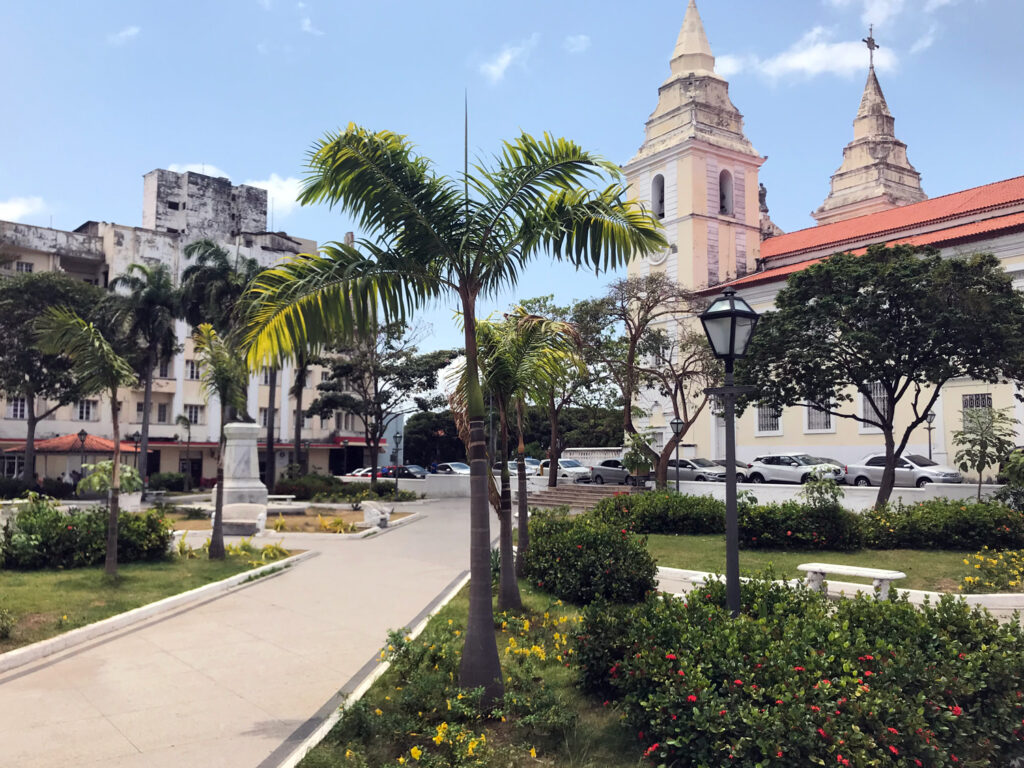
Another way to relax is to sit on one of the benches in the square and watch the people go by.
Originally known as Largo Velho do Val, this place was frequented by prostitutes.
In the 19th century it was urbanised and turned into a botanical garden, which was later dismantled and the railings that surrounded it pulled down. It was named Benedito Pereira Leite Square in honour of the statesman who appears in a statue in the central flowerbed.
6. Rua Portugal and Rua do Trapiche
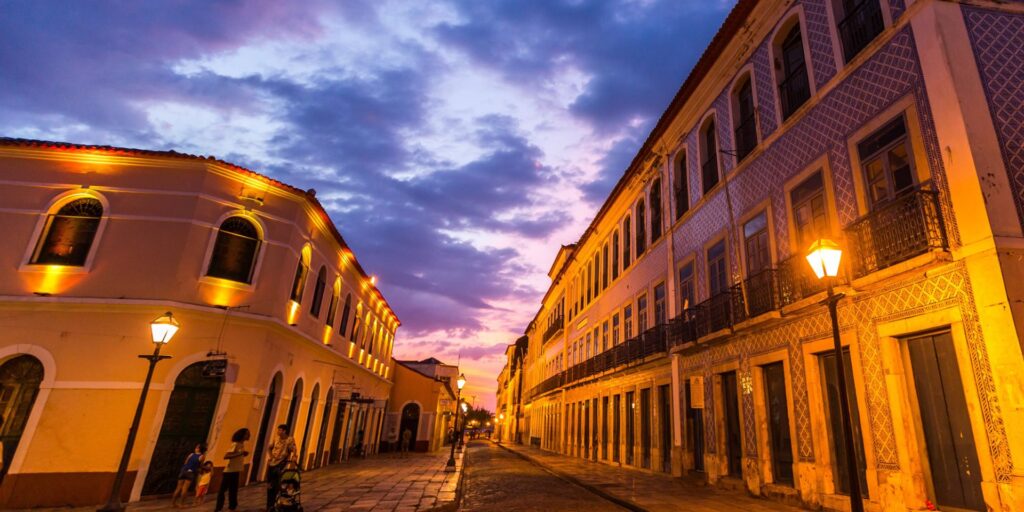
Rua Portugal is one of the main streets in the historic centre of São Luís, where the main commercial establishments were concentrated when it was built.
It still retains its roots today, with several shops and active commerce, as well as government offices. Here you’ll find the Museum of Fine Arts and the Casa de Nhozinho (a museum dedicated to the Maranhão craftsman Antônio Bruno Pinto Nogueira, who spent his life making toys and folklore figures from buriti).
On the corner of Rua Portugal is Rua do Trapiche, where you’re sure to be enchanted by the Mora da Artes, where several artists open their doors to visitors to view their work.
7. Monastery of Mercês
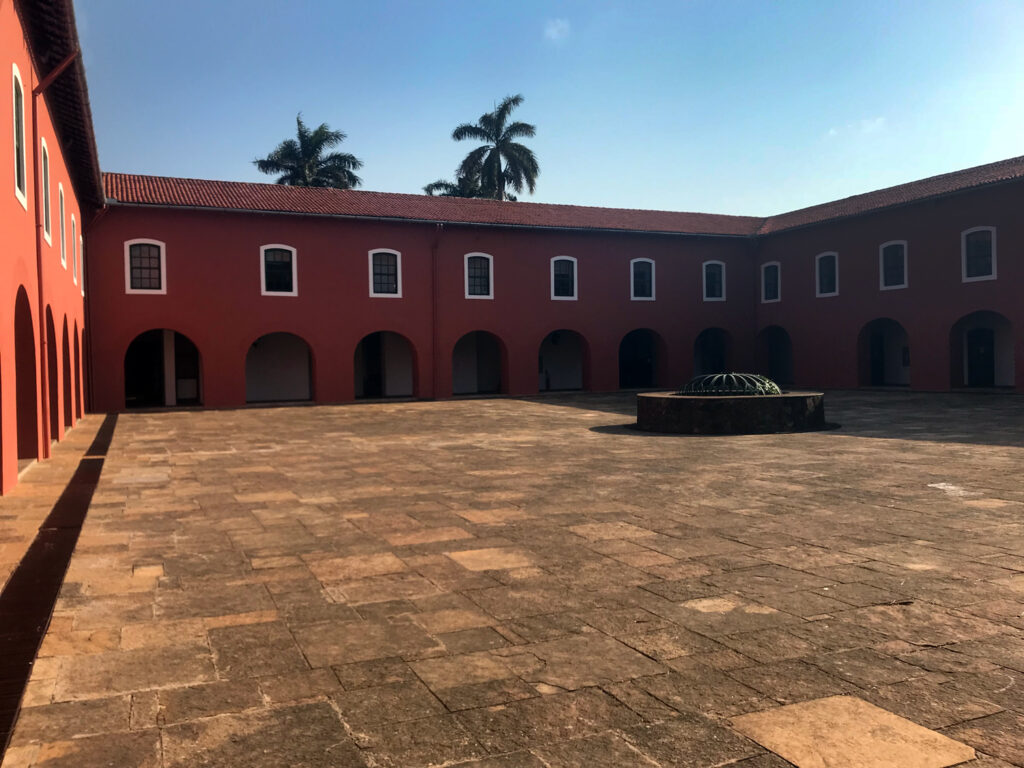
Walking down Rua da Palma, we came to the Convent of Mercês. Built in the 17th century, it is considered one of the seven treasures of São Luís’ material heritage.
In addition to the colonial architecture, you can visit an important exhibition on the history of the Republic, with exhibits donated by former President José Sarney.
8. Arthur Azevedo Theatre
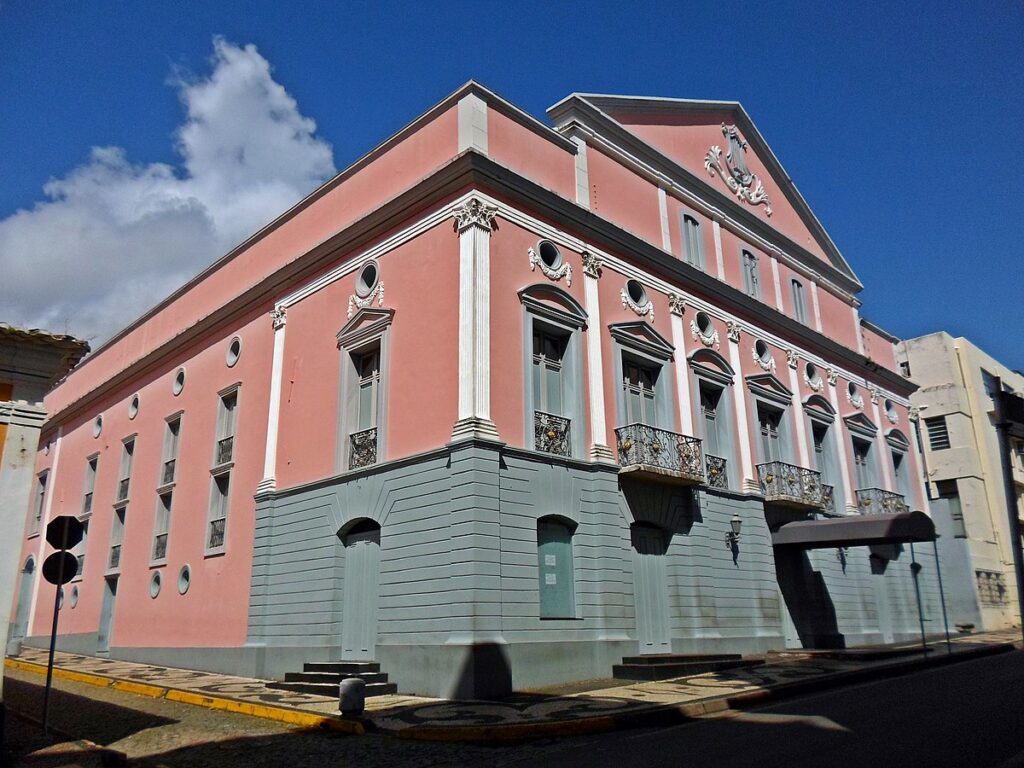
The most famous theatre in São Luís is also one of the oldest in the country. It retains its original neoclassical features, preserving more than 200 years of history and a beauty that few others can match.
Inaugurated in 1817 as the União Theatre, it wasn’t until the following century that it was named after the great master of Brazilian drama.
In the early 1990s, its facilities and equipment were renovated, transforming it into one of the most modern environments for dramatic art in the country.
Address: Rua do Sol, 180 – Centre
Visits: Tuesday to Friday, from 15:00 to 17:00
See History of the Arthur Azevedo Theatre in São Luís do Maranhão.
9. Cafua das Mercês

The Cafua das Mercês is said to have been a trading post for blacks in São Luís, where they were exhibited and sold after disembarking.
Today, the small building houses the Museu do Negro, whose collection includes typical pieces from a slave quarters, a replica of a pillory that used to stand in Largo do Carmo, in the city centre, and a curious collection of African handicrafts made of wood and ivory.
Address: Rua Jacinto Maia, Desterro, next to the Mercês Monastery.
Visits: Tuesday to Sunday, from 9am to 5pm.
10. House of Maranhão
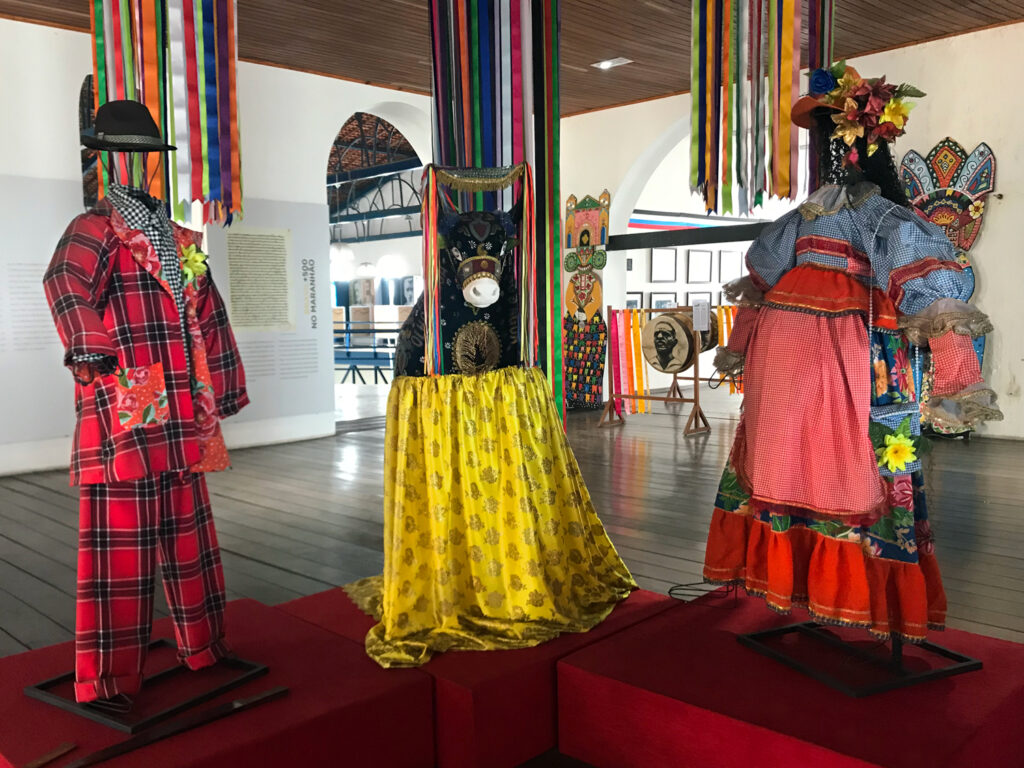
Of all the folklore museums in Maranhão, this was the one I liked best. The exhibition is well organised in the large shed on the second floor of this historic mansion opposite the pier.
It also shows prejudice, this time mainly the racial issue that separated blacks from Europeans.
A large part of the exhibition is devoted to the bullfighting festivals, which began as a game played by slaves and were radically persecuted by politicians and the police, but are now established as a democratic popular manifestation of the State.
11. Largo do Comércio
A typical square in a colonial city. Much of Ludovico’s history took place here. During the 18th and 19th centuries, this street in Praia Grande was used for the city’s commerce and today houses establishments such as bars, restaurants, shops and tourist kiosks.
Despite the economic decline of the 1930s, we still find the houses intact and with all their architectural beauty in the Portuguese colonial style, facades covered with tiles and stonework.
12. Stone Fountain
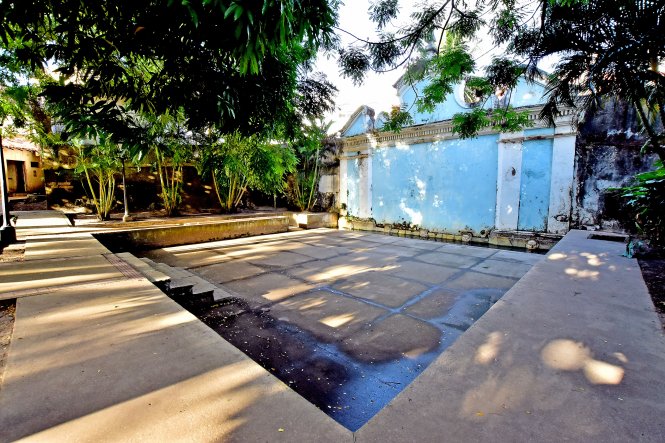
This place is a landmark. It was here, next to what was then a spring, that Jerônimo de Albuquerque camped his troops in October 1615, when he drove the French out of São Luís.
In the best Portuguese colonial style, the Fonte das Pedras (Stone Fountain) is set in a walled quadrangle, with a masonry pediment and carrancas through which the water flows.
Address: Rua de Antonio Rayol, next to the central market.
13. Ribeirão Fountain

There are several mysteries surrounding this monument that make this fountain, built in 1796 to supply water to the population, even more curious. Its base is covered in stone and the water, which is always abundant, gushes from carrancas in a tiled basin.
The frowns are misshapen figures commonly used in fountains, wells and the bow of boats to ward off evil spirits.
The one on the fountain represents Neptune, the mythological god, lord of the seas and waters, who supplied the local population with clean water from his mouth.
There are also fantastic legends about its underground galleries.
It is said to have served as a means of communication between monks from one church to another. It was also used for the transport or escape of slaves and the illegal trade in gold and precious stones. Another legend tells of the enchanted snake that lives in the tunnels of the gallery and grows endlessly. One day, when its tail meets its head, it will destroy the island of São Luís.
Address: between Rua do Ribeirão and Rua dos Afogados.
See History of the Ribeirão Fountain in São Luís do Maranhão.
14. Tulhas Market
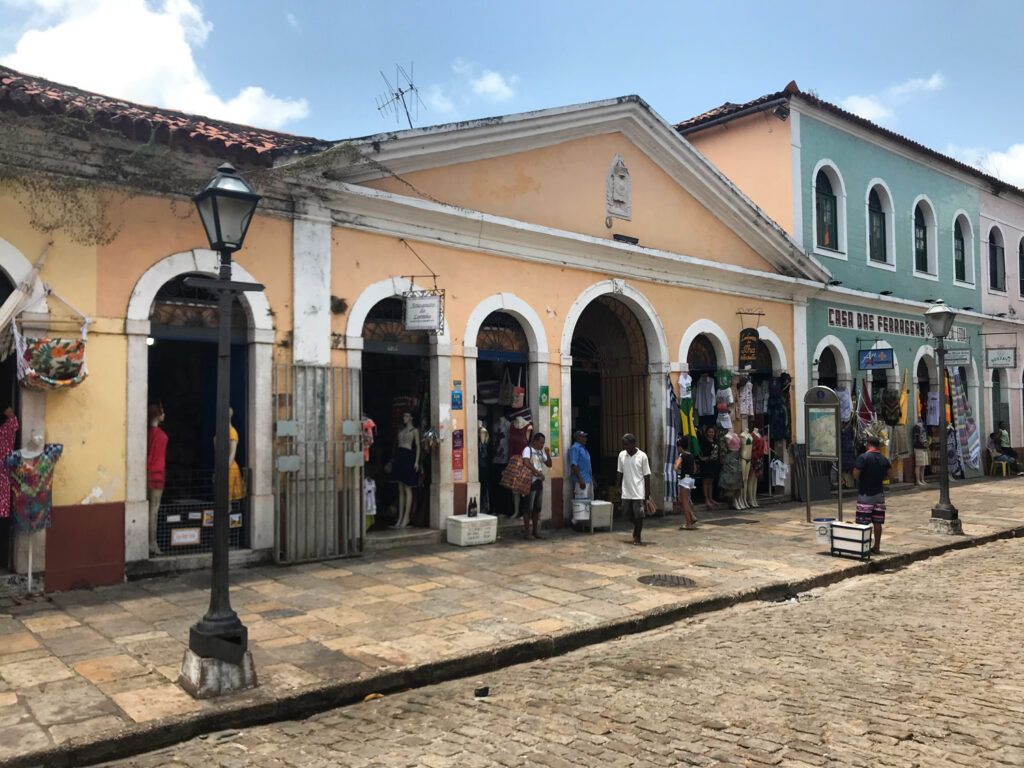
Also known as Feira da Praia Grande, this market is housed in a 19th century building divided into several kiosks selling regional products such as cachaças (including tiquira, made from manioc), sweets, liqueurs, various foods, spices, clothes and accessories, pots and pans, spices and everything else you can imagine.
15. Nhozinho House Museum

The Casa de Nhozinho Museum is housed in a three-storey townhouse with a colonial brick façade.
The name Casa de Nhozinho is a tribute to the great Maranhão craftsman Antônio Bruno Nogueira, known as Nhozinho, who, despite his handicap, made ox-wheels out of buriti.
Visitors can see the production techniques of material culture: pieces of indigenous handicrafts, toys from the 18th and 19th centuries and replicas or originals of typical Maranhão boats.
The museum is named in honour of Antônio Bruno Pinto Nogueira, or Nhozinho, who was born in a coastal town in northern Maranhão at the beginning of the 20th century.
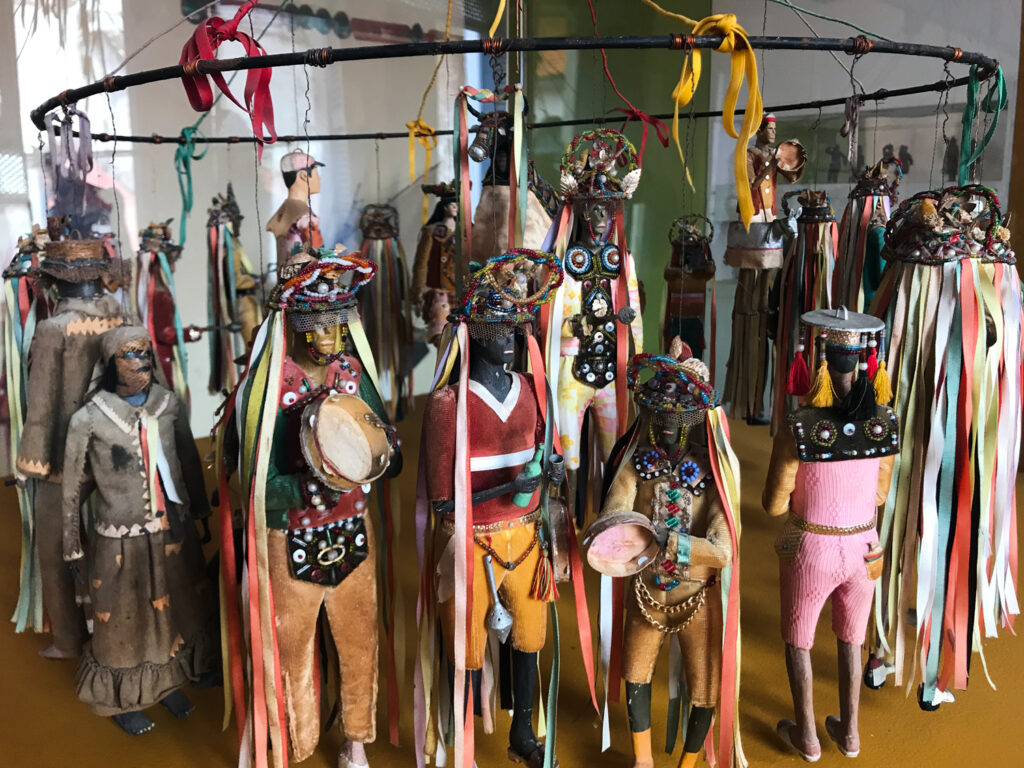
After a normal childhood, at the age of 12 he developed an illness that affected his motor functions.
Confined to bed, he developed his manual skills by making toys and other objects such as cribs, boats, parrots, oxcarts, safes, miniature animals and wooden dolls.
Later, the raw material was replaced by buriti, the porous trunk of a palm tree native to Maranhão, which is softer and easier to cut. In addition to the work of the artisans, the Sobrado also exhibits pieces of different techniques, as well as objects and artefacts from everyday life in the region, such as pestles, oxcarts, fishing tools, miniature boats, costumes from popular festivals and indigenous handicrafts.
Address: Rua Portugal, 185
Visits: Tuesday to Sunday from 9am to 6pm.
16. Solar dos Vasconcelos Museum – Historic Centre Memorial

The Solar dos Vasconcelos was built in the 19th century and is one of the most important examples of architecture in São Luís. It has a beautiful façade with two symmetrical floors and two porches framed by carved stone.
Refurbished and adapted, it houses the collection of the Historic Centre Memorial, with models and photographic panels that document the entire history of the conservation and revitalisation of the Historic Centre of São Luís.
It also houses an important collection of models of typical boats from Maranhão.
Address: Rua da Estrela
Visits: Monday to Friday from 9 am and Saturday from 1 pm.
17. Historical and Artistic Museum of Maranhão

The preserved Solar Gomes de Souza, built in 1836 in the centre of São Luís, belonged to the family of the mathematician, astronomer, philosopher and parliamentarian Joaquim Gomes de Souza, known as Souzinha.
Converted into a museum in 1973, the objects on display – furniture, English and French porcelain, glassware, crystal and, in particular, the Tauromaquia, an oil on canvas from 1950, a genuine work by the Spanish painter Pablo Picasso – reconstruct the environments of wealthy Maranhão residences from the 18th and 19th centuries.
Before going on a guided tour, take a look at the façade, a beautiful example of Portuguese colonial architecture.
Address: Rua do Sol, 302 – Centre
Visits: from 9am to 5.30pm and Saturdays and Sundays from 9am to 5pm.
See Museum of History and Art of Maranhão.
18. Museum of Religious Art

The Museum of Sacred Art is housed in this building next to the cathedral. A visit to the exhibition there is a good opportunity to learn a little about the history of the city, which was founded on a mass celebrated by the Jesuits.
Among the hundreds of pieces on display are sculptures, chalices, crucifixes and other objects used during mass.
The Museum of Sacred Art is located next to the Museum of History and Art. It is housed in a mansion with a tiled façade, once the home of the Baron of Grajaú, Carlos Fernandes Ribeiro, and his wife, the Baroness Anna Rosa Vianna Ribeiro.
Today, it is a unique space for the contemplation and exhibition of the precious treasures that tell the history of the Church of Maranhão. Its collection, part of which belongs to the Archdiocese of São Luís, is made up of pieces from the 18th and 19th centuries in rococo and neoclassical styles.
Address: Rua 13 de Maio, 500 – Centro
Visits: from 9am to 5.30pm and Saturdays and Sundays from 9am to 5pm.
19. Avenue of Catarina Mina

Beco Catarina Mina has a staircase with 35 wide steps made of lioz stones dating from the 13th century. It was named in honour of Mina Catarina Rosa Pereira de Jesus, a slave who had a shop there.
The famous captive, whose story echoes that of another equally famous slave, Xica da Silva, made her fortune through her work and connections with the region’s wealthy merchants, who were literally smitten by her beauty.
Catarina amassed a fortune, bought her freedom and became a slave mistress who could be seen around town, followed by a procession of whimsically dressed women.
Located in Praia Grande, in the historic centre of São Luís.
20. João do Vale Theatre

Located in the heart of the historic centre, in Largo do Comércio, Praia Grande, the João do Vale Theatre is one of the most important cultural centres in São Luís.
It is a tribute to João Batista do Vale, one of Maranhão’s most important artists, chosen as an illustrious figure of the 20th century, whose works have been recorded by Nara Leão, Dolores Duran, Zé Kéti, Chico Buarque and, of course, Maria Bethânia, who performed his greatest hit: “Carcará”.
The João do Vale Theatre hosts regional and national shows, bringing the best of music and theatre to São Luís.
21. Odylo Costa Filho Creativity Centre

A cultural complex in the Praia Grande district, the Ferreira Gullar Library has a collection of works by authors from Maranhão and about Maranhão.
There is also the Cine Praia Grande, which shows art films, a gallery for temporary exhibitions and the 215-seat Alcione Nazaré Theatre, inaugurated in 1988.
The centre also offers art courses in photography, drawing, sculpture and dance.
Address: Rampa do Comércio, 200, Praia Grande
Visits: every day from 8am to 8pm
22. Alcione Nazaré Theatre
Also known as the Praia Grande Theatre, it was built in 1988 to host amateur groups and rehearsals. It was named in honour of the singer Alcione, Marrom, a native of Maranhão.
Address: Rua Rampa do Comércio – 200 – Centro Timetables: Daily, from 8am to 8pm.
Tourist Guide to São Luís do Maranhão and the Northeast
Publicações Relacionadas
Gonçalves Dias Square: A Historic Landmark
Palácio dos Leões: A Historical Landmark Tour
Cafua das Mercês: Preserving Black Memory Today
Convent and the Church of Nossa Senhora do Carmo History
Casa Real Empório: History and Culture Combined
Historical curiosities about São Luís do Maranhão
Josué Montello House of Culture in Maranhão History
Cristo Rei Palace: Architecture of the 19th Century
Catarina Mina: The Story Behind the Alley
Church of Nossa Senhora dos Remédios History
Benedito Leite Public Library's Rich History
Cine Éden: A Historic Cinema in São Luís
This post is also on:
![]() Português
Português ![]() English
English ![]() Deutsch
Deutsch ![]() Español
Español ![]() Français
Français




















